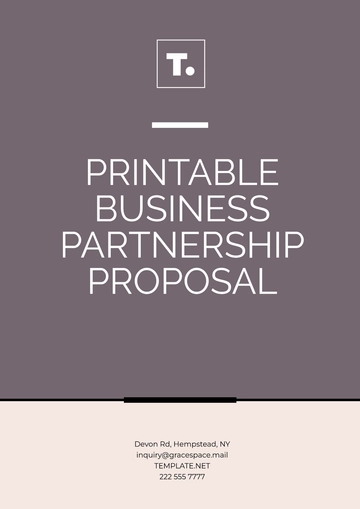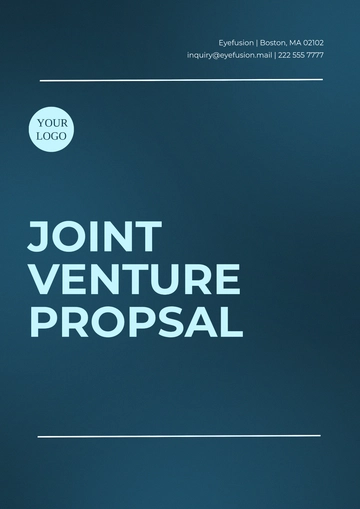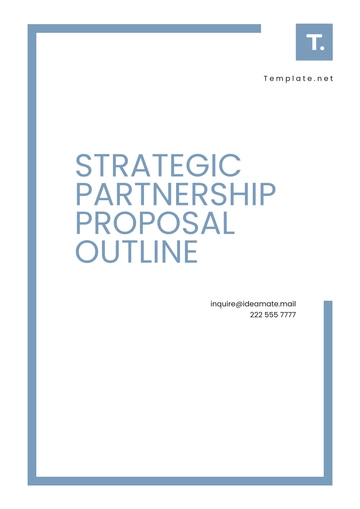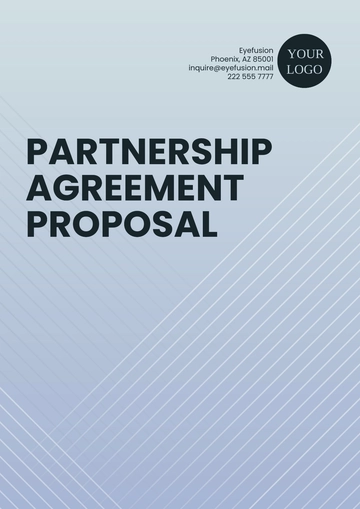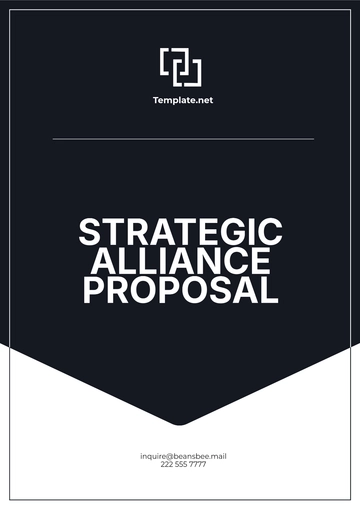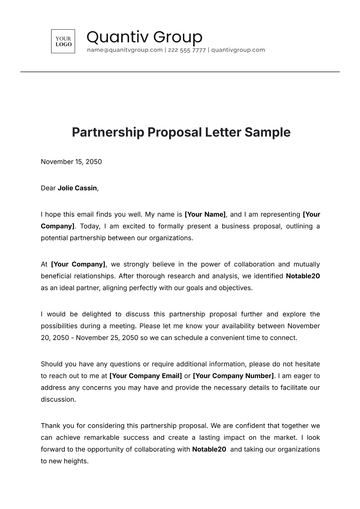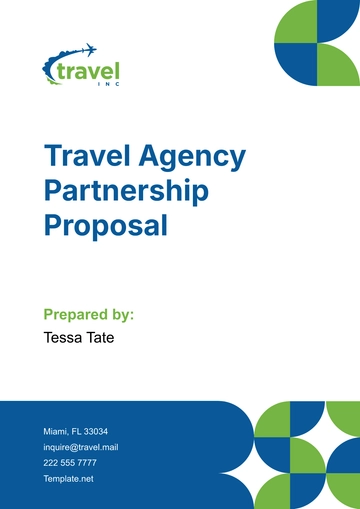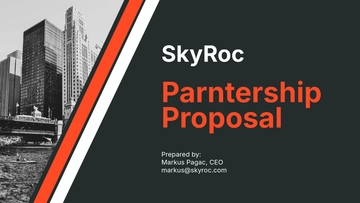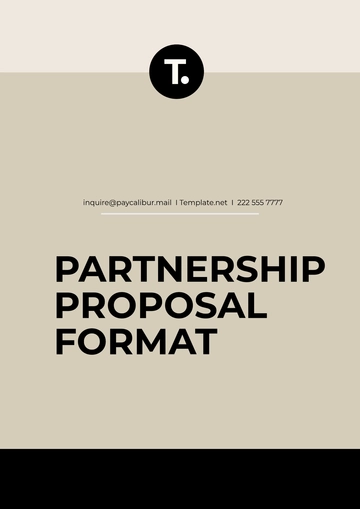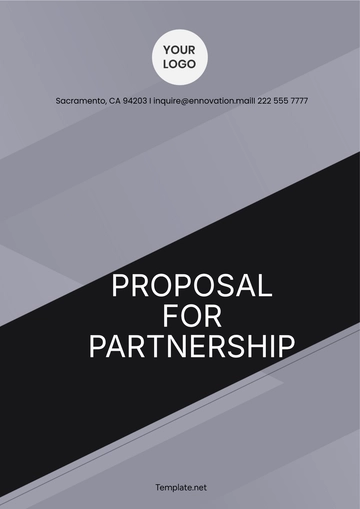Free Restaurant Partnership Proposal

1. Introduction
We are excited to present this Restaurant Partnership Proposal to you. Our goal is to create a mutually beneficial relationship that will enhance both our businesses. At [Your Company Name], we believe that by combining our strengths, we can create a distinctive dining experience that will attract a diverse customer base.
Our proposal outlines the key areas where our partnership can drive growth, innovation, and customer satisfaction. We have carefully considered your restaurant's unique identity and have tailored this proposal to align with your business goals and objectives.
2. Executive Summary
[Your Company Name] is a premier dining establishment dedicated to providing exceptional culinary experiences. We are seeking to establish a strategic partnership with [Partner Company Name] to enhance our market presence, expand our customer base, and drive mutual growth. This proposal outlines the benefits, objectives, and details of the proposed partnership.
3. Company Overview
[Your Company Name]
Founded: [Year]
Location: [City, State]
Type: Mediterranean Cuisine
Mission: To deliver unforgettable dining experiences through innovative Mediterranean cuisine, exceptional service, and a welcoming atmosphere. We pride ourselves on using fresh, locally-sourced ingredients to create dishes that celebrate the rich flavors and culinary traditions of the Mediterranean region. Our mission is to provide a dining experience that not only delights the palate but also fosters a sense of community and warmth.
[Partner Company Name]
Founded: [Year]
Location: [City, State]
Type: Farm-to-Table Restaurant
Mission: To provide a unique and sustainable dining experience by using the freshest ingredients sourced directly from local farms. We are committed to promoting environmental stewardship and supporting the local economy through our farm-to-table approach. Our mission is to create dishes that not only nourish the body but also respect the planet, offering our guests a taste of the freshest produce and meats while ensuring that our operations have a minimal environmental footprint.
4. Market Analysis
Industry Overview
The restaurant industry is a dynamic and competitive sector with significant growth potential. Trends indicate a growing demand for unique dining experiences, healthier menu options, and convenient delivery services.
Target Market
[Your Company Name] targets urban professionals, families, and food enthusiasts who seek high-quality dining experiences. Our market analysis indicates a strong demand in [City] for diverse culinary offerings and exceptional service.
Competitive Landscape
Competitors in the area include:
[Competitor 1 Name]
Known for: High-quality seafood dishes and a waterfront dining experience. This competitor leverages its prime location and scenic views to attract customers looking for a luxurious dining atmosphere.
[Competitor 2 Name]
Specializes in: Authentic Italian cuisine with a focus on traditional recipes and a cozy, family-friendly environment. This competitor emphasizes its heritage and homemade pasta dishes, appealing to customers seeking a genuine Italian dining experience.
[Your Company Name]
Differentiates itself through:
Innovative Cuisine: Our menu features creative Mediterranean dishes that blend traditional flavors with modern culinary techniques, setting us apart in a competitive market.
Personalized Service: We prioritize exceptional customer service, ensuring that each guest feels valued and has a memorable dining experience.
Strategic Partnerships: Collaborations with local farms and suppliers allow us to offer fresh, high-quality ingredients, enhancing our menu and supporting the community. Additionally, partnerships with other businesses provide unique promotional opportunities and events that attract a diverse customer base.
5. Partnership Objectives
Primary Goals
Expand Market Reach: Leverage each partner's customer base to increase visibility and attract new customers.
Enhance Brand Image: Combine strengths to create a stronger, more appealing brand presence.
Increase Revenue: Implement joint marketing and promotional efforts to drive sales and profitability.
Secondary Goals
Operational Synergies: Share best practices and resources to improve operational efficiencies.
Customer Experience: Enhance the overall customer experience through collaborative initiatives and offerings.
Innovation: Foster innovation in menu development, service delivery, and customer engagement.
6. Benefits of Partnership
By partnering with [Your Company Name], your restaurant will gain access to a range of benefits that can help accelerate your business growth. These benefits include:
Marketing and Promotion
Joint Marketing Campaigns: Increase visibility and attract new customers through coordinated marketing efforts.
Brand Exposure: Enhance brand recognition through co-branded promotional materials and events.
Customer Engagement
Exclusive Events: Host events and promotions that foster customer loyalty and repeat business.
Enhanced Customer Experience: Improve customer satisfaction through shared best practices and innovative offerings.
Operational Support
Operational Efficiencies: Share operational insights and best practices to streamline processes and improve service delivery.
Resource Sharing: Leverage shared resources to reduce costs and increase efficiency.
Our team's extensive experience in the industry ensures that we can provide valuable insights and support tailored to your needs.
7. Partnership Details
7.1 Roles and Responsibilities
[Your Company Name]:
Provide Venue: Host joint events and promotions at our restaurant.
Marketing: Promote partnership through social media, email newsletters, and in-restaurant advertising.
Operational Support: Ensure seamless integration of partnership activities into daily operations.
[Partner Company Name]:
Product Supply: Provide high-quality ingredients/products for joint initiatives.
Marketing: Promote partnership through your marketing channels and customer base.
Expertise: Share industry expertise and best practices to enhance partnership outcomes.
7.2 Financial Projections
Revenue Projections:
Year | Projected Revenue Increase | % Growth |
|---|---|---|
1 | $100,000 | 10% |
2 | $150,000 | 15% |
3 | $200,000 | 20% |
Cost Projections:
Year | Marketing Costs | Operational Costs | Total Costs |
|---|---|---|---|
1 | $20,000 | $10,000 | $30,000 |
2 | $25,000 | $12,000 | $37,000 |
3 | $30,000 | $15,000 | $45,000 |
7.3 Marketing and Promotion
Joint Marketing Initiatives:
Social Media Campaigns: Leverage both companies' social media platforms to reach a wider audience.
Email Marketing: Send joint newsletters to our combined email lists, highlighting partnership benefits and promotions.
Events and Promotions: Host exclusive events and special promotions to attract new customers and engage existing ones.
Promotional Materials:
Co-Branded Flyers: Design and distribute co-branded flyers and brochures.
Website Integration: Feature the partnership prominently on both companies' websites.
Customer Engagement: Use loyalty programs and incentives to encourage repeat business.
8. Implementation Plan
The implementation plan for our partnership is structured into three phases: Planning, Execution, and Evaluation and Expansion. Each phase is designed to ensure a smooth and effective collaboration, driving growth and achieving our mutual objectives.
Phase | Duration | Key Activities |
|---|---|---|
Phase 1: Planning | Months 1-2 | Define Partnership Scope: Outline detailed roles, responsibilities, and expectations.Develop Marketing Strategy: Create a comprehensive marketing plan with timelines and deliverables. Legal Agreements: Draft and sign partnership agreements. |
Phase 2: Execution | Months 3-6 | Launch Marketing Campaigns: Implement social media, email, and in-restaurant marketing initiatives. Host Events: Organize and execute joint events and promotions. Monitor Progress: Track key performance indicators and adjust strategies as needed. |
Phase 3: Evaluation and Expansion | Months 7-12 | Evaluate Success: Review financial and operational performance against projections. Optimize Strategies: Make necessary adjustments to marketing and operational plans. Plan for Expansion: Explore opportunities for expanding the partnership to new locations or additional initiatives. |
Phase 1: Planning (Months 1-2)
Define Partnership Scope:
Outline detailed roles, responsibilities, and expectations for both parties to ensure clarity and alignment.
Develop Marketing Strategy:
Create a comprehensive marketing plan that includes timelines, deliverables, and promotional tactics to maximize visibility and engagement.
Legal Agreements:
Draft and sign partnership agreements to formalize the collaboration and protect the interests of both parties.
Phase 2: Execution (Months 3-6)
Launch Marketing Campaigns:
Implement a variety of marketing initiatives, including social media promotions, email campaigns, and in-restaurant advertising, to attract and retain customers.
Host Events:
Organize and execute joint events and promotions that highlight the strengths of the partnership and engage the community.
Monitor Progress:
Track key performance indicators (KPIs) such as sales, customer feedback, and engagement metrics, and adjust strategies as needed to ensure success.
Phase 3: Evaluation and Expansion (Months 7-12)
Evaluate Success:
Review the financial and operational performance of the partnership against initial projections to assess its effectiveness.
Optimize Strategies:
Make necessary adjustments to the marketing and operational plans based on performance data and feedback to improve outcomes.
Plan for Expansion:
Explore opportunities for expanding the partnership to new locations or additional initiatives that can further enhance the growth and success of both businesses.
This structured approach ensures that our partnership is implemented smoothly and effectively, with clear milestones and objectives at each stage.
9. Legal Considerations
Partnership Agreement
A formal partnership agreement will be drafted, outlining:
Terms and Conditions: Legal terms governing the partnership.
Intellectual Property: Rights and usage of brand names, logos, and proprietary information.
Confidentiality: Measures to protect sensitive information shared between partners.
Termination Clause: Conditions under which the partnership can be terminated.
Compliance
Ensure all partnership activities comply with local, state, and federal regulations, including health and safety standards, labor laws, and marketing regulations.
10. Conclusion
The proposed partnership between [Your Company Name] and [Partner Company Name] presents a unique opportunity to leverage our combined strengths, enhance brand presence, and drive mutual growth. By collaborating on marketing initiatives, sharing resources, and focusing on customer experience, we can achieve significant benefits for both parties. We are confident that this partnership will be a successful venture and look forward to working together to achieve our goals.
11. Contact Information
For further information or to discuss this proposal in detail, please contact:
[Your Name]
[Your Title]
[Your Company Name]
[Your Company Address]
Phone: [Your Company Number]
Email: [Your Company Email]
- 100% Customizable, free editor
- Access 1 Million+ Templates, photo’s & graphics
- Download or share as a template
- Click and replace photos, graphics, text, backgrounds
- Resize, crop, AI write & more
- Access advanced editor
Step into the realm of culinary collaboration with Template.net's Restaurant Partnership Proposal Template. Craft compelling proposals that entice potential partners to join forces in culinary ventures. This editable and customizable template empowers you to tailor each proposal to suit your unique vision. With our AI editor tool, create persuasive pitches that pave the way for fruitful partnerships in the restaurant industry.
You may also like
- Business Proposal
- Research Proposal
- Proposal Request
- Project Proposal
- Grant Proposal
- Photography Proposal
- Job Proposal
- Budget Proposal
- Marketing Proposal
- Branding Proposal
- Advertising Proposal
- Sales Proposal
- Startup Proposal
- Event Proposal
- Creative Proposal
- Restaurant Proposal
- Blank Proposal
- One Page Proposal
- Proposal Report
- IT Proposal
- Non Profit Proposal
- Training Proposal
- Construction Proposal
- School Proposal
- Cleaning Proposal
- Contract Proposal
- HR Proposal
- Travel Agency Proposal
- Small Business Proposal
- Investment Proposal
- Bid Proposal
- Retail Business Proposal
- Sponsorship Proposal
- Academic Proposal
- Partnership Proposal
- Work Proposal
- Agency Proposal
- University Proposal
- Accounting Proposal
- Real Estate Proposal
- Hotel Proposal
- Product Proposal
- Advertising Agency Proposal
- Development Proposal
- Loan Proposal
- Website Proposal
- Nursing Home Proposal
- Financial Proposal
- Salon Proposal
- Freelancer Proposal
- Funding Proposal
- Work from Home Proposal
- Company Proposal
- Consulting Proposal
- Educational Proposal
- Construction Bid Proposal
- Interior Design Proposal
- New Product Proposal
- Sports Proposal
- Corporate Proposal
- Food Proposal
- Property Proposal
- Maintenance Proposal
- Purchase Proposal
- Rental Proposal
- Recruitment Proposal
- Social Media Proposal
- Travel Proposal
- Trip Proposal
- Software Proposal
- Conference Proposal
- Graphic Design Proposal
- Law Firm Proposal
- Medical Proposal
- Music Proposal
- Pricing Proposal
- SEO Proposal
- Strategy Proposal
- Technical Proposal
- Coaching Proposal
- Ecommerce Proposal
- Fundraising Proposal
- Landscaping Proposal
- Charity Proposal
- Contractor Proposal
- Exhibition Proposal
- Art Proposal
- Mobile Proposal
- Equipment Proposal
- Student Proposal
- Engineering Proposal
- Business Proposal

